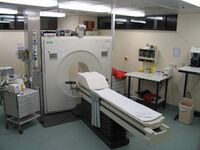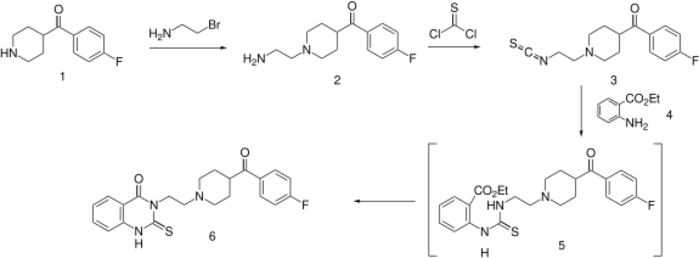Chemistry:Altanserin
 | |
| Clinical data | |
|---|---|
| ATC code |
|
| Identifiers | |
| |
| CAS Number | |
| PubChem CID | |
| ChemSpider | |
| UNII | |
| ChEMBL | |
| Chemical and physical data | |
| Formula | C22H22FN3O2S |
| Molar mass | 411.50 g·mol−1 |
| 3D model (JSmol) | |
| |
| |
| (verify) | |
Altanserin is a compound that binds to the 5-HT2A receptor (5-Hydroxytryptamine (serotonin) 2A receptor). Labeled with the isotope fluorine-18 it is used as a radioligand in positron emission tomography (PET) studies of the brain, i.e., studies of the 5-HT2A neuroreceptors. Besides human neuroimaging studies altanserin has also been used in the study of rats.[1][2]
An alternative for PET imaging the 5-HT2A receptor is the [11C]volinanserin (MDL-100,907) radioligand. 18F-altanserin and 3H-volinanserin have shown very comparable binding.[3] Both altanserin and MDL 100,907 are 5-HT2A receptor antagonists.[3] [18F]-setoperone can also be used in PET.
An alternative SPECT radioligand is the [123I]-5-I-R91150 receptor antagonist.[4]
A rapid chemical synthesis of fluorine-18 and H-2 dual-labeled altanserin has been described.[5]
Other ligands for other parts of the serotonin system used in PET studies are, e.g., DASB, ketanserin, and WAY-100635.
Human brain mapping studies with altanserin
(As of 2007) altanserin is probably not used in clinical routine. However, there have been performed several research-based neuroimaging studies with the compound in humans since the 1990s.[6][7] Some of these studies have considered methodogical issues such as the reproducibility of the method[8][9] or whether to use constant infusion[10] or bolus-infusion[11] delivery of altanserin. Other studies have compared altanserin binding to subject variables such as age, personality trait and neuropsychiatric disorder.
The altanserin PET scan shows high binding in neocortex. The cerebellum is often regarded as a region with no specific 5-HT2A binding and the brain region is used as a reference in some studies, even though an autoradiography study has found nonnegligible levels of 5-HT2A binding in the human cerebellum,[12] and another type of study have observed strong immunoreaction against 5-HT2A receptor protein in rat Purkinje cells.[13]
In the table below is an overview of the results of altanserin binding seen in human PET-studies. A consistent finding across altanserin studies has been that the binding decreases with age. This is in line with in vitro studies of the 5-HT2A receptor,[14] as well as PET studies with other radioligands that binds to the receptor.[15]
The result for recovered bulimia-type anorexia nervosa[16] is in line with a SPECT study of anorexia nervosa patients, that found a decrease in frontal, occipital and parietal cortices.[4] The results of PET studies of the 5-HT2A in depression has been mixed.[17]
Altanserin binding has also been examine in twins, where one study showed higher correlation between monozygotic twin pairs than between dizygotic twin pairs, giving evidence that the binding is "strongly genetically determined".[18]
| What | Result | Reference |
|---|---|---|
| Gender | Higher binding in men | [19] |
| Body mass index | Correlation in cortex | |
| Neuroticism (NEO PI-R) | Increase in frontolimbic region | [20] |
| Tourette syndrome | Increase | [21] |
| Obsessive-compulsive disorder | Increase in caudate nuclei | [22] |
| (Recovered) bulimia-type anorexia nervosa | Decrease in left subgenual cingulate, left parietal cortex and right occipital cortex | [16] |
| Unipolar depression | Decrease in a region in right hemisphere (posterolateral orbitofrontal cortex and the anterior insular cortex) | [23] |
| Major depressive disorder | Decrease in hippocampus | |
| Older depressed patients | Decrease in hippocampus | [24] |
| Borderline personality disorder | Increase in hippocampus | [25] |
| Schizophrenia | No significant cortical difference, higher binding in caudate | [26] |
| At-risk mental state | Decrease | |
| Age | Decrease | [27] |
| Age | Decrease | |
| Age | Decrease in cortical regions (except occipital), increase in cerebellum | [28] |
| Mild cognitive impairment | Decrease | [29] |
| Alzheimer's disease | Decrease in amygdalo-hippocampal complex and cortical regions, such as anterior cingulate, lateral temporal cortex, prefrontal cortex and sensorimotor cortex | [30] |
Synthesis
The reaction of 4-(4-fluorobenzoyl)piperidine [56346-57-7] (1) with 2-bromoethylamine [107-09-5] gives [1-(2-aminoethyl)piperidin-4-yl]-(4-fluorophenyl)methanone [83763-22-8] (2). The reaction of the terminal amino group with thiophosgene [463-71-8] leads to the corresponding isothiocyanate derivative, 4-fluorophenyl 1-(2-isothiocyanatoethyl)piperidin-4-yl ketone [84946-22-5] (3). Upon reaction of this reactive intermediate with ethyl anthranilate [87-25-2] (4), the transient addition product might be expected to be initially formed (5'). An intramolecular lactamization to the heterocyclic ring then occurs giving altanserin (6).
See also
References
- ↑ "Fluorine-18-altanserin: a radioligand for the study of serotonin receptors with PET: radiolabeling and in vivo biologic behavior in rats". Journal of Nuclear Medicine 32 (12): 2266–2272. December 1991. PMID 1744713.
- ↑ "In vivo binding of [18F]altanserin to rat brain 5HT2 receptors: a film and electronic autoradiographic study". Nuclear Medicine and Biology 24 (4): 357–360. May 1997. doi:10.1016/s0969-8051(97)00054-1. PMID 9257335.
- ↑ 3.0 3.1 "Binding characteristics of the 5-HT2A receptor antagonists altanserin and MDL 100907". Synapse 58 (4): 249–257. December 2005. doi:10.1002/syn.20205. PMID 16206185.
- ↑ 4.0 4.1 "Decreased 5-HT2a receptor binding in patients with anorexia nervosa". Journal of Nuclear Medicine 44 (2): 163–169. February 2003. PMID 12571204.
- ↑ 5.0 5.1 "Rapid synthesis of F-18 and H-2 dual-labeled altanserin, a metabolically resistant PET ligand for 5-HT2a receptors". Journal of Labelled Compounds and Radiopharmaceuticals 42 (5): 457–467. 1999. doi:10.1002/(SICI)1099-1344(199905)42:5<457::AID-JLCR206>3.0.CO;2-0. ISSN 0362-4803.
- ↑ "Multicompartmental study of fluorine-18 altanserin binding to brain 5HT2 receptors in humans using positron emission tomography". European Journal of Nuclear Medicine 21 (9): 937–946. September 1994. doi:10.1007/BF00238117. PMID 7995287.
- ↑ "Serotonin 5HT2 receptor imaging in the human brain using positron emission tomography and a new radioligand, [18F]altanserin: results in young normal controls". Journal of Cerebral Blood Flow and Metabolism 15 (5): 787–797. September 1995. doi:10.1038/jcbfm.1995.99. PMID 7673371.
- ↑ "Test-retest variability of serotonin 5-HT2A receptor binding measured with positron emission tomography and [18F]altanserin in the human brain". Synapse 30 (4): 380–392. December 1998. doi:10.1002/(SICI)1098-2396(199812)30:4<380::AID-SYN5>3.0.CO;2-U. PMID 9826230.
- ↑ "Reproducibility of 5-HT2A receptor measurements and sample size estimations with [18F]altanserin PET using a bolus/infusion approach". European Journal of Nuclear Medicine and Molecular Imaging 34 (6): 910–915. June 2007. doi:10.1007/s00259-006-0296-y. PMID 17195073.
- ↑ "PET quantification of 5-HT2A receptors in the human brain: a constant infusion paradigm with [18Faltanserin"]. Journal of Nuclear Medicine 41 (2): 234–241. February 2000. PMID 10688105. http://jnm.snmjournals.org/cgi/content/abstract/41/2/234.
- ↑ "Quantification of 5-HT2A receptors in the human brain using [18F]altanserin-PET and the bolus/infusion approach". Journal of Cerebral Blood Flow and Metabolism 23 (8): 985–996. August 2003. doi:10.1097/01.WCB.0000074092.59115.23. PMID 12902843.
- ↑ "Expression of serotonin 5-HT(2A) receptors in the human cerebellum and alterations in schizophrenia". Synapse 42 (2): 104–114. November 2001. doi:10.1002/syn.1106. PMID 11574947.
- ↑ "Serotonin2A receptor-like immunoreactivity in rat cerebellar Purkinje cells". Neuroscience Letters 252 (1): 72–74. August 1998. doi:10.1016/S0304-3940(98)00546-1. PMID 9756362.
- ↑ "Serotonin-2 binding sites in human frontal cortex and hippocampus. Selective loss of S-2A sites with age". Brain Research 311 (1): 51–56. October 1984. doi:10.1016/0006-8993(84)91397-0. PMID 6488044.
- ↑ "Effects of age on dopamine and serotonin receptors measured by positron tomography in the living human brain". Science 226 (4681): 1393–1396. December 1984. doi:10.1126/science.6334363. PMID 6334363. Bibcode: 1984Sci...226.1393W.
- ↑ 16.0 16.1 "Altered 5-HT(2A) receptor binding after recovery from bulimia-type anorexia nervosa: relationships to harm avoidance and drive for thinness". Neuropsychopharmacology 29 (6): 1143–1155. June 2004. doi:10.1038/sj.npp.1300430. PMID 15054474.
- ↑ "Imaging serotonergic neurotransmission in depression: hippocampal pathophysiology may mirror global brain alterations". Biological Psychiatry 48 (8): 801–812. October 2000. doi:10.1016/s0006-3223(00)00960-4. PMID 11063976.
- ↑ "The 5-HT2A receptor binding pattern in the human brain is strongly genetically determined". NeuroImage 40 (3): 1175–1180. April 2008. doi:10.1016/j.neuroimage.2007.09.019. PMID 18291676.
- ↑ "Sex difference in 5HT2 receptor in the living human brain". Neuroscience Letters 204 (1–2): 25–28. February 1996. doi:10.1016/0304-3940(96)12307-7. PMID 8929969.
- ↑ "Frontolimbic serotonin 2A receptor binding in healthy subjects is associated with personality risk factors for affective disorder". Biological Psychiatry 63 (6): 569–576. March 2008. doi:10.1016/j.biopsych.2007.07.009. PMID 17884017.
- ↑ "Cerebral 5-HT2A receptor binding is increased in patients with Tourette's syndrome". The International Journal of Neuropsychopharmacology 10 (2): 245–252. April 2007. doi:10.1017/S1461145706006559. PMID 16945163.
- ↑ "Patients with obsessive-compulsive disorder have increased 5-HT2A receptor binding in the caudate nuclei". The International Journal of Neuropsychopharmacology 8 (3): 391–401. September 2005. doi:10.1017/S1461145705005055. PMID 15801987.
- ↑ "Serotonin 5-HT2 receptor imaging in major depression: focal changes in orbito-insular cortex". The British Journal of Psychiatry 171 (5): 444–448. November 1997. doi:10.1192/bjp.171.5.444. PMID 9463603.
- ↑ "Decreased hippocampal 5-HT(2A) receptor binding in older depressed patients using [18F]altanserin positron emission tomography". Neuropsychopharmacology 29 (12): 2235–2241. December 2004. doi:10.1038/sj.npp.1300555. PMID 15367923.
- ↑ "5HT2A receptor binding is increased in borderline personality disorder". Biological Psychiatry 62 (6): 580–587. September 2007. doi:10.1016/j.biopsych.2006.10.022. PMID 17448449.
- ↑ "Cortical and subcortical 5-HT2A receptor binding in neuroleptic-naive first-episode schizophrenic patients". Neuropsychopharmacology 33 (10): 2435–2441. September 2008. doi:10.1038/sj.npp.1301656. PMID 18288096. Electronic publication ahead of print
- ↑ "Visualisation of loss of 5-HT2A receptors with age in healthy volunteers using [18F]altanserin and positron emission tomographic imaging". Psychiatry Research 68 (1): 11–22. November 1996. doi:10.1016/S0925-4927(96)02806-5. PMID 9027929.
- ↑ "A database of [(18)F]-altanserin binding to 5-HT(2A) receptors in normal volunteers: normative data and relationship to physiological and demographic variables". NeuroImage 21 (3): 1105–1113. March 2004. doi:10.1016/j.neuroimage.2003.10.046. PMID 15006678.
- ↑ "Reduced 5-HT2A receptor binding in patients with mild cognitive impairment". Neurobiology of Aging 29 (12): 1830–1838. December 2008. doi:10.1016/j.neurobiolaging.2007.04.011. PMID 17544547.
- ↑ "PET imaging of serotonin type 2A receptors in late-life neuropsychiatric disorders". The American Journal of Psychiatry 156 (12): 1871–1878. December 1999. doi:10.1176/ajp.156.12.1871. PMID 10588399.
- ↑ EP0013612 idem Jan Vandenberk, Ludo Kennis, Marcel Van der Aa, Albert Van Heertum, U.S. Patent 4,522,945 (1985 to Janssen Pharmaceutica N.V.).
- ↑ "Time-efficient and convenient synthesis of [(18)F]altanserin for human PET imaging by a new work-up procedure". Applied Radiation and Isotopes 67 (11): 2040–2043. November 2009. doi:10.1016/j.apradiso.2009.07.020. PMID 19692252.
- ↑ "Automatic Synthesis of [(18)F]Altanserin, a Radiopharmaceutical for Positron Emission Tomographic Studies of the Serotonergic Type-2 Receptors". Clinical Positron Imaging 1 (2): 111–116. March 1998. doi:10.1016/s1095-0397(98)00005-3. PMID 14516599.
 |



